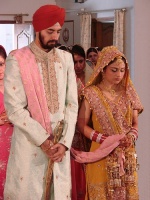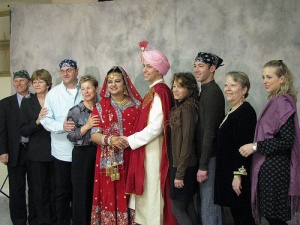Attending a Sikh Wedding
If you are invited to a Sikh wedding, don’t panic! Below is a brief guide on what to expect and what you should wear. Most Sikh weddings are great fun occasions and provided that you are properly prepared, it should be a great day out! A Sikh wedding is a long affair - so be prepared to start early and finish late. Have a good rest the previous day and be fresh and relaxed for the wedding day.
As a general rule the morning and early afternoon are taken up by the religious ceremony at the Sikh temple called the Gurdwara. While, these days the afternoon lunch is held at a different venue away from the Gurdwara, this is a departure from earlier traditions when the lunch consisted of a sumptuous langar at the Gurdwara. There is some pressure from Sikh religious organisations for this tradition to be restored. However, you will have lot to take in and huge amount of food to eat. But be careful, take it easy!
What to wear

If you’re invited to the formal religious ceremony and you are unable to wear a salwar kameez or sari or an ethnic dress then bear the following in mind.
At most Sikh wedding the men will wear a western suit usually in dark colour like blue, brown, grey, etc. while a few will wear a lighter colour like lime, beige, etc. Some men will wear traditional Punjabi or ethnic dress. Most women will wear traditional Punjabi dress in bright colours the preferred being blue, orange, brown, green, multi-colours, pink, etc.
Dress sense
- Modest dress is the order of the day; bare shoulders, plunging necklines and short skirts will be out of place at a religious venue but will be fine for the reception which normally does not take place in the Gurdwara. Some ladies prefer to take a shawl that they can throw over their shoulders, and wear pants to the Gurdwara and then wear a skirt to the reception. That way your outfit is acceptable at both venues.
- For the religious part of the ceremony, you will need to sit on the carpet floor. You will be expected to sit cross-legged or otherwise on the floor for at least 45 minutes and this will prove difficult in tight or short clothing, so dress accordingly.
Colours to wear It is a tradition in Sikh culture to wear vibrant and joyous colours to such occasions. You will witness bright reds, radiant blues, deep green and a huge mixture of these and others colours among the ladies. Although, it is better to avoid pure white and black at the actual religious ceremony there is nothing sacrosanct but you may feel a little out of place in some situations. It is easier for men may get away with a black suit at the religious ceremony.
Bright colours are certainly considered most auspicious at Asian weddings functions; pastels are also acceptable, especially in the summer. Try not to wear bright red as this is traditionally reserved for the bride and you wouldn’t want to outshine her on her special day!
In the Gurdwara
At a Sikh wedding you will be require to cover your head when you are in the Gurdwara (temple). Carry a long scarf or a pashmina stole, which can also be used to cover up bare shoulders or arms, if necessary. Men usually wear the head covering provided at the temple or carry a large white or coloured handkerchief to place over their head.
Removing shoes
Also at the religious places will require you to take off your shoes and place them in the designated space before you enter the sanctified area. While some places may require you to be barefooted, usually wearing socks or stockings is acceptable.
However, it is possible to attend just the formal religious wedding itself or just the lunch and gathering in the afternoon. Check with the host to clarify the exact programme.
The Wedding day protocol
The day usually starts early for the "Barat" which is the term used for the Groom’s side or the party of people accompanying the Groom.
- 1. Departure of Barat: Barat is the term used to describe the party from the Grooms side. The Barat will leave from the Groom's house to the Gurdwara, usually near the Bride's house, where the actual wedding will take place. The arrangements for the rest of the day are normally made entirely by the Bride's family. However, some of this is now changing. If the groom lives far from the bride's house, the Barat may depart early in the morning. It is common for the Barat to set off from the groom's house at 8am. The Barat will then travel to the local area where the bride lives.
- 2. Reception of Barat: The Groom's party is "received" by the Bride's party at the Gurdwara. This usually takes place at about 9.30am.
- 3. Milnea: (means "Introductions") The Ardas will be performed by the priest (Giani) followed by the formal introductions of the main male players in the families. This will include the bride's & groom's father, grandfather and Mama - (mother's brother). They will formally meet, exchange garlands (and gifts) and have their photographs taken. This normally takes place in the foyer area of the Gurdwara at about 10am.
- 4. Tea: Tea with savouries (normally samosa, pakoras) and sweets (generally jalebis, ladoos and barfi) will be served and are normally taken standing at tables. Chairs are seldom provided. Both the Grooms side and Brides side would take tea in turn and this would be concluded at about 10.30am.
- 5. Main Wedding Ceremony (Anand Karaj)
- This is the formal part of the ceremony and always takes place in a Gurdwara. After tea, at about 11am, everyone proceeds to go into the Darbar sahib or main prayer hall. Please observe the rules applicable which are described at Visiting a Gurdwara. Also described here is the type of clothing that should be worn.
- Please note that you will be required to remove your shoes and cover your head in an appropriate manner before entering the main hall. Proceed into the darbar sahib paying attention to and observing the etiquette appropriate in the Darbar Hall. Always show respect to the Guru Granth Sahib as the Guru is held in high esteem by the Sikhs.
- Once in the main hall, you will be expected to sit on the carpeted floor for at least 45 minutes. It is essential that suitable clothing be worn. The formal part of the wedding ceremony normally starts at about 11am and ends at about 1pm and comprises of the following functions:
- a. Kirtan - The singing of the Holy Hymns - Gurbani. As you enter the darbar hall, musical singing of sacred hymns from the holy scriptures will already be taking place. The Kirtaini jatha (religious singers) will be seated on a stage in front of the hall next to the central stage of the Guru. The Guru Granth Sahib will be attended by a Sewadar (volunteer Sikh) or Giani (priest) who will be waving a Chaur over the Guru. After several Shabads (hymns) have been sang, the priest (Giani) or the stage secretary will announce the timetable for the formal part of Anand Karaj ceremony in the darbar hall.
- b. Ardas – Key People (Bride, groom, both parents of bride and groom) will stand straight with folded hands and join in this prayer.
- e. Sagaan – The parents of Bride and Groom followed by key people and the congregation will bless the newly wedded and give gifts or money and have photos taken.
- f. Kara Parshad – Blessed "Sweet pudding" is served. This ends the formal part of the Sikh wedding ceremony.
- 6. Lunch: Previously this used to be Langar at the Gurdwara but now it is lunch at a commercial venue. When held in a commercial venue, it is like a normal "dinner & dance" type of event. Loud "Bhangra" music is played and alcohol and meat may be served!
- 7. Departure of Doli: The bride changes into new clothes that are presented to her by the groom's family. She will then departs from her parent's house (a very sad and touching occasion).
- 8. Reception: (Optional) This may be held on the same day or another day and is an evening "dinner and dance" type occasion, sometimes not too formal (please check with the party) where only invited guests from both familes can attend.
See also
External links
- BBC on Sikh weddings - Anand Karaj
- Etiquette guide: attending a South Asian wedding ceremony
- Anand Karaj - A Union of Two Souls
References
- All photos courtesy of Flickr.com
| Gurus: | Nanak Dev | Guru Angad | Amar Das | Ram Das | Guru Arjan | Har Gobind | Har Rai | Har Krishan | Tegh Bahadur | Gobind Singh | Guru Granth Sahib | Sikh Bhagats |
| Philosophy: | Sikh Beliefs | Simran | Sewa | Beliefs and Principles | Underlying Values | Prohibitions | Technique and Methods | Other observations | Technique and Methods |
| Practices: | Ardas | Amrit Sanskar | Chardi Kala | Dasvandh | Five Ks | Kirat Karni | Kirtan | Langar | Naam Japna | Simran | Three Pillars | Vand Chakna | Five Evils | Five Virtues |
| Scripture: | Guru Granth Sahib | Sikh Scripture | Dasam Granth | Ek Onkar | Waheguru | Bani | Mool Mantar | Japji Sahib | Jaap Sahib | Chaupai | Anand Sahib | Tav-Prasad Savaiye | Rehras | Sukhmani |
| More: | History | Gurdwaras | Harmandir Sahib | Khalsa | Khanda | Names | Places | News | Satguru | Sikhs | Bhagat Farid | Bhagat Kabir | Websites | Biographical | Terms |

